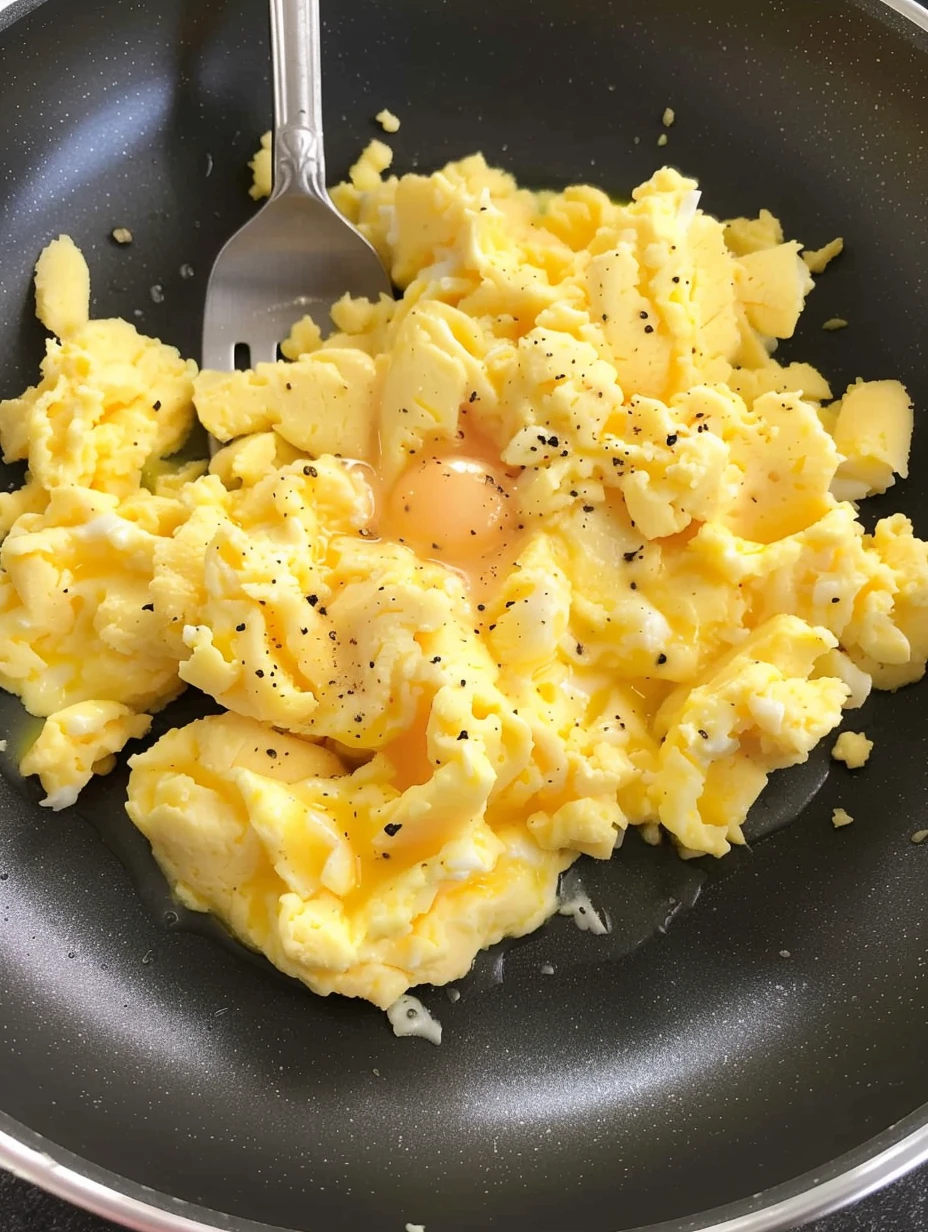Perfect Scrambled Eggs: The Only Recipe You’ll Ever Need
Is there any breakfast more comforting or iconic than a plateful of Perfect Scrambled Eggs? For many of us, these tender, buttery curds are the first real “dish” we learn to make in our own kitchens. Yet, despite their simplicity, there’s an art to achieving scrambled eggs that are truly fluffy, creamy, and melt-in-your-mouth delicious. Whether you’re looking for the ultimate weekend brunch or a nourishing weekday breakfast, this guide will walk you through every detail, ensuring your scrambled eggs are flawless—every single time.
The secret to Perfect Scrambled Eggs isn’t elusive, but it does involve some key tips and a gentle touch. In this comprehensive blog post, I’ll share the exact method I use at home, honed through years of family breakfasts and countless batches. You’ll discover why technique and timing matter, how to avoid common missteps (no rubbery eggs here!), and all the simple tools you’ll need. Get ready to master scrambled eggs once and for all—because once you taste the best, there’s no going back!
Why You’ll Love Perfect Scrambled Eggs
- Silky, fluffy texture every single time—goodbye rubbery eggs!
- Incredibly fast to make, with breakfast on the table in just minutes.
- Customizable to fit every mood and dietary preference.
- Minimal ingredients, maximum flavor.
- Boosts your morning with nutrients and energy for the day ahead.
- Delicious for all ages, from preschoolers to grandparents.
- Versatile as a base for numerous additions and pairings.
Ingredients for Perfect Scrambled Eggs
The beauty of Perfect Scrambled Eggs lies in their simplicity. With just a handful of staple ingredients, you’ll create something memorable and satisfying—every time. Each component counts, so let’s dive into what you’ll need:
- 4 large eggs
- Fresh eggs make a difference! The yolks are creamier, and the whites bind better, resulting in fluffier scrambled eggs.
- 2 tablespoons unsalted butter
- Butter provides a rich flavor and helps create that silky texture. Unsalted lets you control the final seasoning.
- Salt (start with about 1/4 teaspoon)
- Salt is essential for bringing out the natural savoriness of eggs. Kosher or sea salt dissolves beautifully.
- Freshly ground black pepper
- Adds a mild kick and subtle aroma. Grind fresh for best taste.
- (Optional: Add-ins such as cheese, fresh herbs, or a splash of cream can be included if you want to experiment—more details below!)
These humble ingredients, when combined with the right technique, transform into scrambled eggs that are anything but basic. The best part? You probably already have everything in your fridge and pantry!
Necessary Tools
Making Perfect Scrambled Eggs doesn’t require fancy gadgets or elaborate cookware—just a few reliable essentials you likely already own. Having the right tools ensures your eggs cook efficiently and clean up is a breeze:
- Nonstick skillet
- A medium-sized nonstick pan is truly the secret weapon for scrambled eggs. It keeps the eggs from sticking while letting you use less fat and ensuring effortless stirring.
- Silicone spatula
- The flexible edges make it easy to gently push and fold the eggs, preserving their tender texture.
- Medium mixing bowl
- Use a bowl large enough to give your eggs room to whisk up frothy and uniform.
- Balloon whisk or fork
- Thoroughly whisking the eggs introduces air, generating fluffier results.
- Measuring spoons
- For precision when adding salt, pepper, and butter.
- Small jug or pitcher (optional)
- If you like to pour your eggs in a steady stream for extra control.
- Plate and fork for serving
Make sure everything is within reach before you get started—scrambled eggs come together fast!
Ingredient Additions & Substitutions
One of the joys of Perfect Scrambled Eggs is their adaptability. Whether you’re working with dietary restrictions, shifting tastes, or a particularly creative morning, scrambled eggs are the ideal culinary canvas. Here’s how you can personalize and reinvent this breakfast staple:
Additions:
- Cheese:
- Stir in grated cheddar, Swiss, feta, or goat cheese just before the eggs finish cooking. Cheese adds creaminess and complexity.
- Herbs:
- Chopped chives, parsley, dill, or tarragon infuse freshness and color. Sprinkle over the eggs after cooking for a burst of flavor.
- Cream or Milk:
- For ultra-luxurious eggs, whisk in a tablespoon of heavy cream, whole milk, or crème fraîche with the eggs.
- Veggies:
- Sautéed mushrooms, spinach, tomatoes, or peppers can be folded in for more substance and nutrition. Cook them separately and add at the end to prevent sogginess.
- Proteins:
- Bacon bits, smoked salmon, cooked sausage, or even a handful of cooked shrimp transform these eggs into a complete meal.
Substitutions:
- Butter:
- For dairy-free diets, use a plant-based buttery spread or a good drizzle of olive oil.
- Eggs:
- If you’re avoiding eggs for allergy reasons, try a plant-based egg substitute like JUST Egg.
- Salt & Pepper:
- Sodium-free or low-sodium alternatives work if you’re reducing salt intake. Pepper can be replaced with other mild spices like paprika.
- Nonstick Pan:
- Stainless steel or even well-seasoned cast iron can work in a pinch, but be sure to use extra butter or oil and watch closely for sticking.
Whatever your needs, the fundamental technique remains the same—gentle heat, constant stirring, and mindful seasoning. Trust your palate and pantry, and soon, you’ll have a signature version of Perfect Scrambled Eggs that’s all your own.
How to Make Perfect Scrambled Eggs
Scrambled eggs are the picture of breakfast simplicity, but there’s a sweet spot between creamy, custardy eggs and overcooked, rubbery ones. The method below, developed after years of practice (and learning from a few cautionary tales), guarantees a plate of Perfect Scrambled Eggs with minimal fuss.
Step 1: Whisk the Eggs Thoroughly
Crack your eggs into a medium bowl, adding salt and pepper right away. Grab your whisk or fork and beat vigorously until the mixture is completely homogenous—no streaks of white or yolk. Whisking isn’t just about breaking up eggs; it’s about adding air, which means fluffier, lighter eggs.
Step 2: Pre-Heat and Butter Your Pan
Place your nonstick skillet over medium heat. Drop in your unsalted butter and let it melt, swirling it to coat the entire surface, including up the sides. It’s crucial that the butter melts slowly and doesn’t brown—medium-low heat is your friend here.
Step 3: Pour and Wait
Once the butter is fully melted and ever so slightly foamy (not brown), reduce the heat to medium-low. Pour in your whisked eggs. At this stage, nothing will seem to happen—resist the urge to increase the heat! Good things come to those who wait.
Step 4: Gently Push and Fold
After a minute or two, you’ll notice soft curds beginning to form. With your spatula, gently push the eggs from the edges toward the center, folding them over on themselves. Let uncooked egg flow to the heated surface. Stir consistently but gently, scraping the bottom and sides to keep eggs moving without breaking them down completely.
Step 5: Remove from Heat Early
When eggs look about 90% set—still streaked with glossiness and a tad underdone—promptly remove the pan from heat. Eggs continue to cook from residual heat, and this step is what separates perfect, moist eggs from dry, grainy ones.
Step 6: Finish and Serve
Keep stirring the eggs off the heat for another 10-15 seconds until they reach your preferred doneness. Slide immediately onto a plate—waiting even a minute in the hot pan can overcook them. Serve piping hot, maybe with an extra sprinkle of salt, a grind of pepper, or your favorite herbs.
Serving Suggestions
The possibilities for serving Perfect Scrambled Eggs are delightfully endless. Here are a few ways to jazz up your breakfast or brunch spread:
- Classic on Toast:
- Top a thick slice of sourdough, rye, or your favorite seeded bread with scrambled eggs. Add butter or a schmear of avocado for extra richness.
- Eggs & Greens:
- Pile eggs onto a bed of sautéed spinach, arugula, or even a light mixed salad for a nutrient-dense boost.
- With Protein:
- Pair with crispy bacon, maple-sweetened sausage, grilled ham, or smoked salmon for a hearty meal.
- Breakfast Wrap:
- Wrap the eggs, plus some sautéed peppers and onions, in a whole wheat tortilla for an on-the-go breakfast.
- Shakshuka-Style:
- Spoon over a bed of spiced tomato sauce for a Mediterranean twist.
- Hearty Sides:
- Serve alongside roasted potatoes, hash browns, or grilled tomatoes for the ultimate breakfast platter.
The next time you crave a restaurant-worthy breakfast at home, Perfect Scrambled Eggs will always rise to the occasion.
Pro Tips & Tricks
When it comes to scrambled eggs, the margin between sublime and “meh” is razor-thin. These expert tips will help you find and stay on the right side of that line:
- Start with Room-Temperature Eggs:
- They whisk up more consistently and cook more evenly.
- Whisk Longer Than You Think:
- Ten seconds more can be the difference between streaky and perfectly blended eggs.
- Use Gentle, Consistent Heat:
- Keep the heat at medium-low to avoid tough, dried-out curds.
- Don’t Overcrowd the Pan:
- A medium skillet (8–10 inches) is just right for up to four eggs.
- Be Patient:
- Let eggs sit undisturbed for the first minute or so before you begin to gently move them.
- Finish Off the Heat:
- Eggs are delicate—remove them while they’re still glossy; they’ll finish cooking with residual warmth.
- Clean the Pan Immediately:
- While the pan is still warm, a quick wipe makes cleanup effortless.
- Add Cheese near the very end—too soon, and it will pool as excess oil.
With these tricks stashed in your back pocket, every batch will be a breakfast triumph.
Storage Instructions
While scrambled eggs are at their very best hot from the pan, sometimes you need to prep ahead. Here’s how to store and reheat your Perfect Scrambled Eggs:
- Refrigeration:
- Cool eggs completely, then store in an airtight container in the refrigerator. Scrambled eggs will keep for up to 3 days.
- Reheating:
- Gently reheat in a nonstick skillet over very low heat, stirring consistently to avoid overcooking. A splash of milk or cream added during reheating helps restore their creamy texture.
- Microwave Option:
- Use a microwave-safe plate or bowl, heat in short bursts (10–15 seconds), stirring between intervals. Do not overheat, as they can dry out quickly.
- Freezing:
- Not recommended, as the texture may become rubbery and watery.
Proper storage preserves both safety and flavor, making it easy to enjoy eggs even on the busiest mornings.
General Information
Perfect Scrambled Eggs aren’t just delicious—they’re a nutritional powerhouse and a classic comfort. Here are some additional facts:
- Eggs are rich in protein, B vitamins, vitamin D, and essential amino acids.
- Butter adds healthy fat and flavor, but you can substitute olive oil or avocado oil for a lighter version.
- Scrambled eggs are gluten-free by nature—making them a safe option for many diets.
- This preparation is naturally low-carb and works with paleo, keto, and vegetarian plans.
- Customizable for all ages—from toddlers (cut-up, bite-sized) to adults with sophisticated add-ins.
- Ideal for singles or crowds, as the recipe easily scales up or down.
With this recipe in your repertoire, Perfect Scrambled Eggs will always be just minutes away, whatever the occasion or dietary need.
FAQs
Can I use milk or cream in my scrambled eggs?
Absolutely! A splash of milk, cream, or even crème fraîche whisked into the eggs will create a softer, creamier texture. Just avoid adding too much—about 1 tablespoon per 2 eggs is ideal.
Why are my scrambled eggs rubbery?
This is nearly always due to high heat or overcooking. Stick to medium-low heat and remove the eggs while they’re still slightly underdone—the residual heat will carry them to perfection.
Can I double or halve the recipe?
Yes! Scrambled eggs are easy to scale. For larger batches, use a slightly larger pan and stir more regularly to ensure even cooking.
What’s the best way to keep scrambled eggs warm for a crowd?
After cooking, transfer eggs to a warmed dish placed atop a tray of hot water (a makeshift bain-marie) and cover loosely with foil. Stir gently every few minutes to keep from drying out.
Can I make scrambled eggs ahead of time?
Scrambled eggs are best fresh, but you can refrigerate leftovers. Reheat gently to preserve their creamy texture.
Should I season eggs before or after cooking?
Seasoning before cooking means the salt disperses evenly, helping the eggs retain moisture and develop flavor throughout.
Conclusion
There’s nothing quite like the satisfaction of nailing a batch of Perfect Scrambled Eggs—soft but not runny, richly flavored, and ready to pair with your favorite morning treats. With just eggs, butter, salt, and a bit of time, you can elevate this humble dish into something genuinely special. Next time you’re craving comfort and simplicity at breakfast (or any meal!), return to this time-tested recipe and savor the results.
Nutritional Information
A serving of Perfect Scrambled Eggs (prepared as above with 2 eggs and 1 tablespoon of butter per person) offers an impressive nutrient profile:
- Calories: Approximately 250 per serving
- Protein: Roughly 14 grams, ideal for sustained energy and muscle maintenance
- Total Fat: Around 21 grams, with 8 grams saturated fat from butter (substitute as needed)
- Carbohydrates: Less than 2 grams—making this dish friendly for most low-carb diets
- Cholesterol: About 350 mg (part of a balanced diet for most people)
- Sodium: 350-400 mg, depending on added salt
In addition, eggs deliver vital nutrients like vitamin B12, choline, selenium, and antioxidants lutein and zeaxanthin, supporting brain, eye, and overall health. Butter, when used in moderation, offers flavor along with fat-soluble vitamins A, D, and E.
As always, enjoy your Perfect Scrambled Eggs as part of a vibrant, balanced breakfast. Happy cooking!
Print
Scrambled Eggs: Perfect Scrambled Eggs Every Time
- Total Time: 10 minutes
- Yield: 2
Description
Scrambled Eggs are a classic breakfast dish that delivers fluffy, creamy, and tender curds when prepared properly. This method uses gentle heat and a nonstick skillet to ensure soft and luscious eggs. Melted unsalted butter enriches the eggs, while careful folding and patience prevent overcooking. Serve them right away for the best results.
Ingredients
- 2 tablespoons unsalted butter
- 4 large eggs
- 1/4 teaspoon salt, or to taste
- Freshly ground black pepper, to taste
Instructions
- Crack the eggs into a small bowl and whisk thoroughly until fully combined and streak-free. Season with salt and pepper.
- Heat a medium nonstick skillet over medium heat. Add the butter and let it melt completely, swirling the pan to coat.
- Reduce heat to medium-low. Pour in the whisked eggs.
- Allow eggs to cook undisturbed for a minute or two until curds begin to form.
- With a spatula, slowly and gently push and fold the eggs across the skillet, ensuring the liquid parts contact the pan.
- Continue stirring frequently and gently, folding rather than scrambling aggressively.
- When the eggs are mostly set but still look slightly wet, immediately remove the pan from heat.
- Keep folding off the heat until eggs reach your preferred doneness. Serve immediately.
Notes
For substitution, you can use olive oil or plant-based butter in place of unsalted butter, and a pinch of garlic powder or chopped herbs for added flavor. Make-ahead tip: Scrambled eggs are best made fresh, but can be gently reheated over low heat. To store, refrigerate in an airtight container for up to 2 days. If eggs turn rubbery, you likely used too high heat—always cook low and slow.
- Prep Time: 5 minutes
- Cook Time: 5 minutes
- Category: Breakfast
- Method: Stovetop
- Cuisine: American

